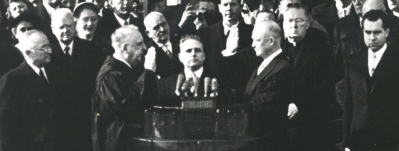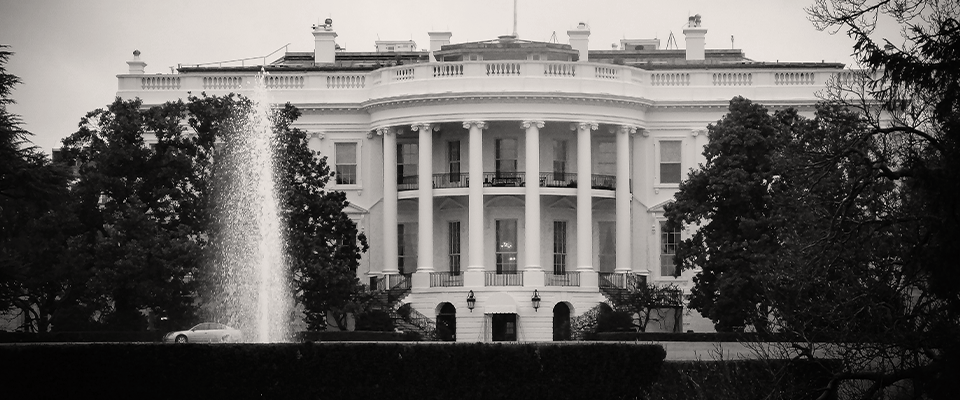The on-again-off-again détente between the outgoing and incoming administrations was off before apparently being on again—at least, as of this writing—with The Donald tweeting last week, “Doing my best to disregard the many inflammatory President O statements and roadblocks. Thought it was going to be a smooth transition – NOT!” only to reverse himself a few hours later when he told reporters that the transition was going “very, very smoothly.”
So has it always been this awkward?
“Well, we got off to a good start with the first transition, between George Washington and John Adams in 1796,” says Catherine Allgor, former Professor of History at UC Riverside who currently serves as Director of Education at the Huntington Library, Art Collections and Botanical Gardens. It was all going so smoothly, in fact, that in a letter recounting the inauguration that Adams sent to his wife Abigail, he imagines Washington telling him, ‘I am fairly out and you are fairly in. See which of us will be the happiest!’ “But it went downhill very quickly. Four years later at the second transition, between Adams and Thomas Jefferson, feelings were so bitter that Adams left town at four o’clock in the morning rather than attend Jefferson’s inauguration.”
There were also newspaper reports at the time that Adams partisans removed the ropes from the bell clappers at nearby churches so they couldn’t ring the bells in Jefferson’s honor, an act that Gil Troy, Professor of History at McGill University, calls “an ungracious symbolic moment that anticipates the Clinton people,” who removed some of the W keys from keyboards in the White House when they left.
Only two other presidents have boycotted their successors’ inaugurations: Adams’ son, John Quincy Adams, who stayed away from Andrew Jackson’s swearing-in in 1829, and Andrew Johnson, who was absent from Ulysses S. Grant’s in 1869. Adams was angry because pro-Jackson newspapers had accused him of procuring young American girls for the Russian Czar’s depraved pleasures when he was minister to Russia— anticipating the last election’s fake news story about Hillary Clinton running a child sex slave ring out of a Washington DC pizza parlor—and Johnson was mad at Grant for refusing to support him during the impeachment crisis.

But it’s almost come to that several other times, such as 1953, when incoming president Dwight D. Eisenhower broke tradition by refusing to enter the White House for the customary pre-inaugural cup of coffee with the Trumans, preferring to wait in the car with his wife Mamie for Harry and Bess Truman to come out and join them for the ride to the Capitol. Truman responded by declaring he wouldn’t attend the inauguration at all, resulting in a tense standoff while the two men waited to see who would blink first. The impasse was finally broken when Bess, who had never been fond of life in the White House, said sternly, “Harry, I’ve been waiting for eight years to get out of this place, and you’re not going to delay me one second longer!”
The two men had once been close—four years earlier, Truman had even offered to step down and run as Ike’s vice president—but all that was forgotten when Eisenhower failed to defend Truman’s hero, Gen. George Marshall, who had chosen Ike for supreme command in World War II but was now under attack by Joe McCarthy for supposedly being “soft” on communism. “He’s just a coward,” said Truman. “He ought to be ashamed for what he did.” When Ike heard about that he said, “I wonder if I can stand sitting next to this guy.”
Things went from bad to worse when Truman surprised Ike by pulling his son, John Eisenhower, who was on active duty in Korea, out of service and flying him back to Washington DC so he could attend his father’s inauguration.
“Truman thought he was doing him a favor; but to Ike, that smacked of preferential treatment, and he was furious. He thought Truman was trying to embarrass him,” says Carl Anthony, historian at the National First Ladies Library. “They were still sniping at each other about it in the car all the way to the Capitol.” In his memoir, Upstairs At The White House, chief White House usher J.B. West wrote, “I was glad I wasn’t in that car.”
Ike was still fuming three years later when Truman’s presidential library was dedicated. He not only refused to attend the ceremony, he lobbied Herbert Hoover to skip it, too. But Hoover, who after 12 years in the wilderness during Franklin D. Roosevelt’s presidency was grateful to Truman for rehabilitating his reputation, which included appointing him chairman of the Hoover Commission on government waste and restoring Hoover Dam’s original name, which FDR had petulantly changed to Boulder Dam, turned him down, saying, “I wouldn’t miss it.”
The Hoover-Roosevelt handoff in 1933 was no love fest either. One of the most famous New Yorker covers of all time, a Peter Arno cartoon depicting a glum

Hoover sitting in the car next to a grinning Roosevelt, actually never ran because it was pulled at the last minute due to an assassination attempt a few days earlier that missed FDR but killed Chicago Mayor Anton Cermak, who was standing next to him (Cermak’s last words, which are inscribed on his tombstone, were “I’m glad it was me instead of you, Frank.”).
But photographs of the real inaugural parade show that Arno’s cartoon, which he drew several weeks before the event, was amazingly prescient, with Roosevelt happily chatting away at an unsmiling Hoover, who was doing his best to ignore him.
The two men had said some nasty things about each other during the campaign. Hoover called Roosevelt “a chameleon on plaid,” and FDR responded by calling Hoover a “fat, timid capon.” But Steven Hayward, Ronald Reagan Professor of Public Policy at Pepperdine University, who is a visiting scholar at Cal’s Institute of Governmental Studies (“I wanted to get out of the conservative ghetto for a while,” he explains ) says the tension between the two men was political, not personal.
“That often happens when the transition is taking place during a crisis, like the Great Depression. The outgoing president wants the incoming president to endorse his policies, and the incoming president doesn’t want his hands tied. Hoover wanted to be helpful to Roosevelt, sending him letters asking, ‘Is there something you’d like me to begin now?’ But his letters went unanswered. Roosevelt wanted to start with a clean slate. The downside was that the delay just prolonged the agony of the banks, which were failing.”
In 1933, FDR, having experienced the problems caused by a long delay between election and inauguration, which in those days took place on March 4, FDR moved the swearing-in up to its present date, January 20.

“Ironically, a lot of people think that, if anything, the too-long transition period has now become too short,” says Hayward. “For the last 30 years it’s taken almost a year to fill all the positions at the president’s disposal. Even filling the big, cabinet-level jobs by January 20 is almost impossible, what with FBI checks, Senate hearings, and filibusters.”
Daniel Sargent, Associate Professor of History at UC Berkeley, disagrees. “The delay we’re experiencing this time says more about the Trump campaign than it does about the Constitutional order,” he says. “We’re dealing with a campaign that was less prepared for the transition than any campaign since Bob Dole in ’96, who had no hope of winning. Every election since then, both the Republican and the Democratic candidates have entertained a reasonable hope of winning, so they planned ahead. But Trump clearly did not to expect to win this, so he was slow getting started. If Kasich had been the nominee he would have been ready to go on November 10.”
One complicating factor in any transition is the presidents’ families, who often take winning and losing even harder than the presidents themselves. “No matter who follows you, you know they don’t deserve to be there,” Betty Ford once said. As she and her husband stood at the door of the White House, waiting for the Carters to arrive for the ride to the Capitol, she turned to him and said, “I really don’t want to do this.”
“You’ve got to do it,” he replied. “We have to be good sports here.”
Ford was true to his word, giving good advice to the man who beat him, urging him to make friends with House Speaker Tip O’Neill, whom Ford got along well with even though they were from opposing parties. Unfortunately, Carter didn’t take it.
“Carter forgot to invite O’Neill to the Inaugural Ball, and everything got off on the wrong foot for the rest of his term,” says Terri Bimes, Assistant Research Director at UC Berkeley’s Institute of Governmental Studies (though other sources say that Carter invited O’Neill but denied his last-minute guests good seats). “So when Reagan took over four years later, he made sure to give Tip good seats for the inaugural ceremony and invited him to the ball.”
Julia Grant didn’t want to leave the White House, either. When the 1876 election between Samuel J. Tilden and Rutherford B. Hayes ended in a deadlock over electoral votes from four states, including Florida—sound familiar?—Julia thought she’d found a way to extend her time as First Lady. She suggested to Ulysses that he remain president until the dispute could be resolved, which could have taken months, even years. He wisely demurred, and when Congress finally decided in favor of Hayes, she wept bitterly as she departed the executive mansion, wailing, “Oh, Ulys (her nickname for him)! I feel like a waif, like a waif on the world’s wide common!”
Frances Cleveland was even more unwilling to let go. When her husband Grover was defeated for reelection by Benjamin Harrison in 1888, her parting words to the White House staff as she walked out the door were, “I want you to take good care of all the furniture and ornaments in the White House, for I want to find everything just as it is now when we come back again four years from today.”
And they did come back four years later when Cleveland beat Harrison in a rematch, making him the only president to serve two non-consecutive terms. And true to Frances’ instructions, everything was just as it was.
Transitions can difficult even between presidents of the same party, such as Reagan and Bush 41 in 1989.
“A new president prefers people who are loyal to him, and Bush inherited a lot of people who were loyal to Reagan,” says Hayward. “There was still a rivalry between the Bush faction and the people who beat them for the nomination eight years (earlier). If Hillary had won this time, I’ll bet you’d see the same thing between her team and Obama’s.”
But sometimes presidents rise above the rough-and-tumble of the campaign, even presidents of different parties, such as Carter and Reagan in 1980, who put aside their differences on the morning of the inauguration to collaborate on the freeing of the Iran hostages, after which Reagan sent Carter to Germany to welcome them back.

“But the gold standard is the Bush 43-Obama transition in 2008,” says Sargent. “It showed our democracy at our very best. Bush granted Obama’s request to ask Congress to release $350 billion of bank bailout funds, and at the start of his Inaugural address Obama praised Bush for his service to the nation and his generosity during the transition. At a time in history when partisan rancor has stymied the function of our representative democracy, that transition still endures as an example of deference to the national interest, when men and women of both parties were able to come together to orchestrate an orderly, peaceful transition of power. We should cherish that, and Bush and Obama are both to be lauded.”
But for sheer graciousness, it’s hard to beat Bush’s father, who in 1993 left his successor, a man he’d called a draft dodger, a letter that started a tradition that presidents have followed ever since:
“Dear Bill, When I walked into this office just now, I felt the same sense of wonder and respect that I felt four years ago. I know you will feel that, too. I wish you great happiness here. I never felt the loneliness some presidents have described. There will be very tough times, made even more difficult by criticism you may not think is fair. I’m not a very good one to give advice; but just don’t let the critics discourage you or push you off course. You will be our President when you read this. I wish you well. I wish your family well. Your success now is our country’s success. I am rooting hard for you. Good luck, George”





















